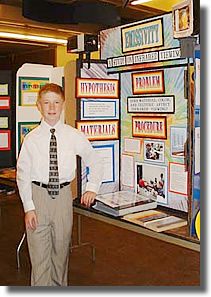Shay Wins District Science Fair

Norco, CA – Shay Edwards, 12 year old science student at Highland Elementary School in Norco, California won the District Science Fair on March 8, 2003. Shay, whose project was related to infrared, competed against more than 600 entries submitted by students in grades six through eight. As a result of his victory, Edwards will go up against competitors from a four county area in April 2003.
Shay was introduced to attendees of Infraspection Institute’s conference and trade show, IR/INFO, held in Orlando, FL in January 2003 when Olivier Beauchemin highlighted Shay’s interest in infrared studies during a presentation at the same conference. Beauchemin said that Shay had contacted www.irinfo.org, a web site maintained by Infraspection Institute, and expressed a desire to utilize information from the site in a school project. The request was passed on to James Seffrin, Director of Infraspection Institute, who stated “We welcome the opportunity to assist the studies of students interested in our growing technology.” Christopher Seffrin, Publisher of www.irinfo.org, noted, “It’s wonderful to see infrared technology capturing the attention of young students as they are the future of our industry.”
During Mr. Beauchemin’s presentation, information concerning Shay’s project was shared with attendees with the promise to report on Shay’s upcoming competitions. An abstract of this project follows below.
Note: We hope to have more information about Shay’s upcoming competition along with more detail about the project as time progresses.
www.irinfo.org wishes Shay all the best in the upcoming competition.
Abstract
The purpose of my science project was to study the influence of the surface and temperature of a material on its ability to emit infrared radiation. I wanted to see if material, color, and texture affected infrared viewing.
I will also be studying the transmission of infrared light through materials. I hypothesized that only material affected infrared viewing, not color or texture.
To test my hypothesis I decided to use colored tapes. I gathered as many different colors and textures as I could find. I put them on the side of a wood box. An 8-12 micron infrared camera with digital imagery was used in a controlled environment.
I proceeded to test for emissivity. I also gathered paper paint squares and put them on the side of a metal box. I tested again with the same camera. Testing was also preformed on glass, Teflon, Styrofoam, tin, schedule 80 pipe, ice cylinder with a cavity in the center, a cardboard box, and me.
A small oxygen activated rapid oxidation hand warmer was also tested inside or behind all test objects. Every item tested was photographed before and during the testing. All results were recorded in a logbook.
Advertisement

